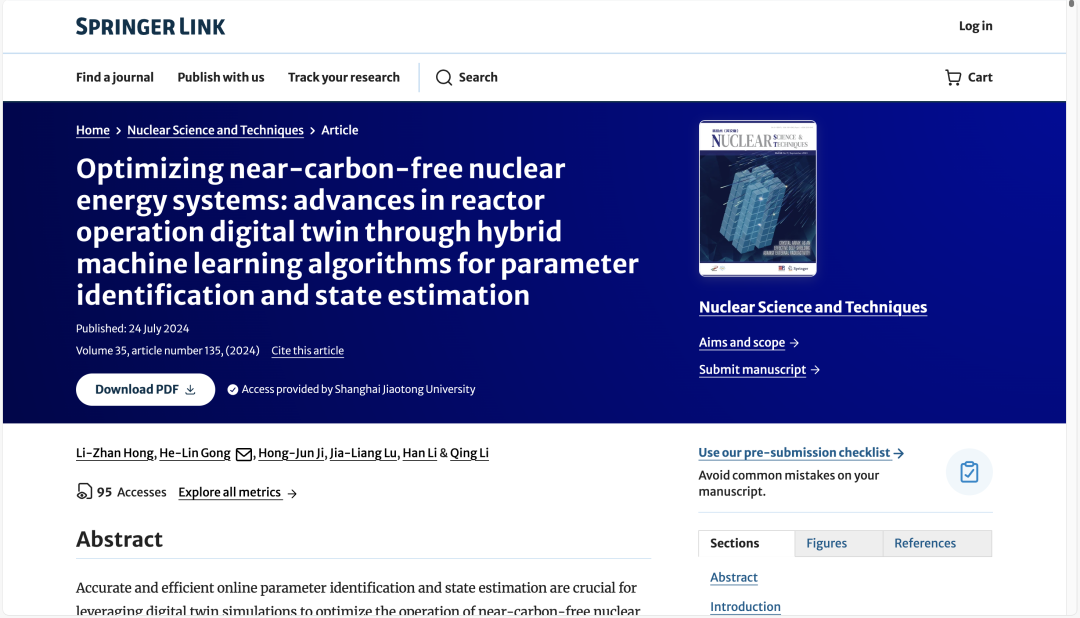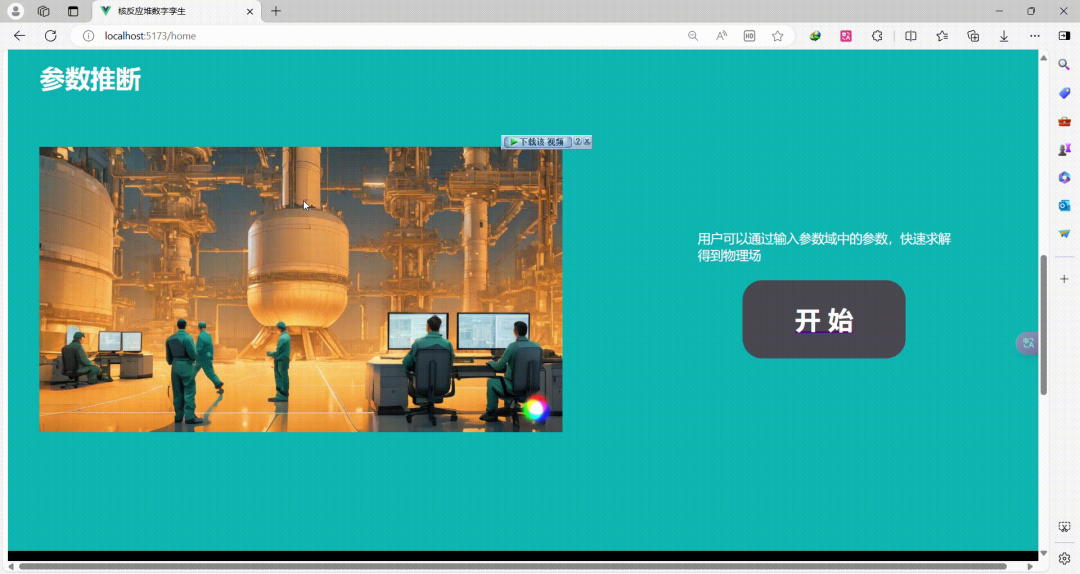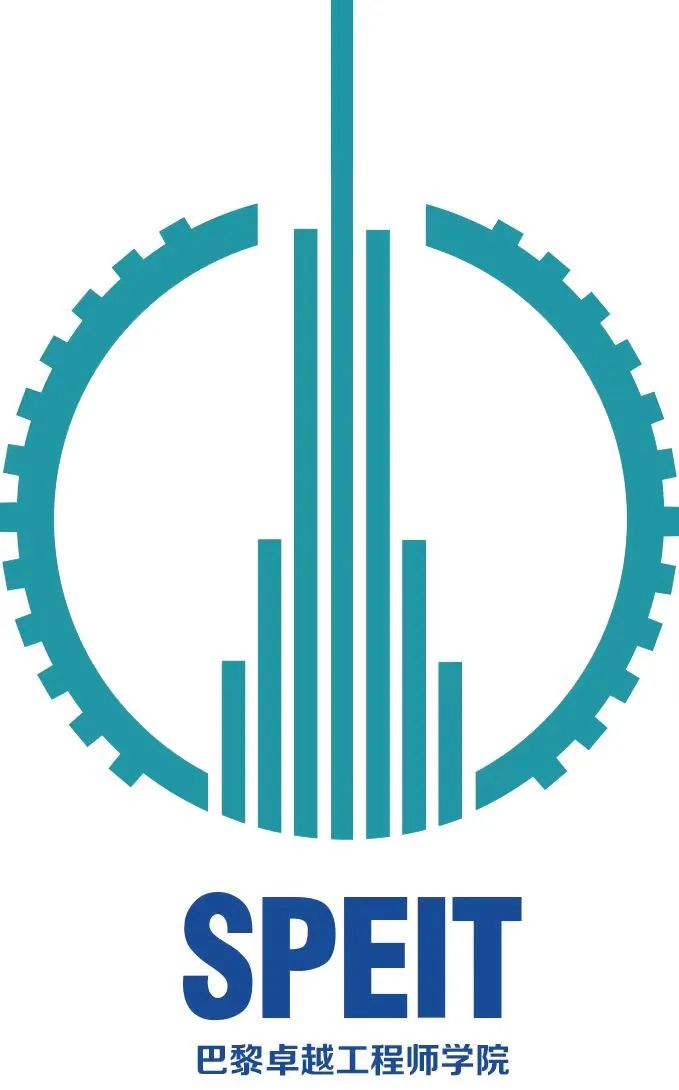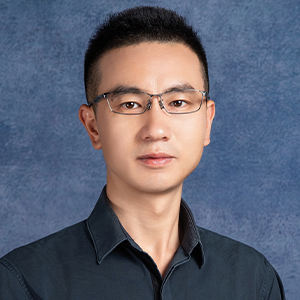
Recently, Hong Lizhan, an undergraduate student from Professor Gong Helin's AISEA research group at SPEIT, published a research paper titled "On the accuracy and efficiency of the reactor operation digital twin for parameter identification and state estimation" in the renowned journal Nuclear Science and Techniques (NST), which specializes in nuclear science and technology.
Hong Lizhan, a 2022 undergraduate student of the Paris School of Excellence in Engineering, is the first author of the paper, Associate Professor Gong Helin is the corresponding author, and the co-authors are Associate Professor Ji Hongjun and Associate Professor Lu Jialiang of the School of Excellence in Engineers, Li Han, a 2022 master's student, and researcher Li Qing, a nuclear engineering expert from the China Nuclear Power Research and Design Institute.

Background:
As the digital transformation of the global economy has become an irreversible trend, the digital economy has become a new hot spot in the global economy, and countries have launched corresponding strategies to seize the opportunity. General Secretary Xi Jinping stressed that digital transformation is a new driving force for the development of the world economy. China is actively embracing and leading this wave of change.
Digital twin technology enables a virtual mapping of the entire life cycle of a physical product by integrating physical models, sensor data, and historical operating data. This technology not only promotes the digitalization, networking and intelligence of the industry, but also becomes an important driving force for China's economic and social development.
In the field of predictive maintenance, digital twin technology has shown its unique value. For example, the Reactor Operational Twin (RODT) technology relies on the software model and real-time data acquisition of the physical entity to provide real-time monitoring and intelligent support for the operation of the reactor. Through improved parameter identification and state estimation, digital twin technology is able to optimize reactor monitoring, control, and performance, revolutionizing nuclear engineering practice.
Research pathways
and innovative results
Based on the domestic nuclear reactor design software CORCA-SIM, the research team proposed the architecture of RODT, and studied a variety of machine learning algorithms and other heuristic algorithms to improve the accuracy and efficiency of RODT-related forward and negative problem calculations. Through rigorous computational performance evaluation, the KNNLHS algorithm stands out for its accuracy and efficiency in real-time online computing, with a prediction error of only 1% and a processing time of less than 0.1 seconds. Algorithms such as FSA, DE and ADE have a longer processing time but higher accuracy, reaching a relative binorm error of 0.3%.

The following diagram illustrates the software interface and visual interface of RODT:


Application prospects
Against the backdrop of the State Council's recent approval of the construction of several nuclear power plants, RODT (Reactor Operation Twin) technology plays a crucial role in supporting the operation of these new nuclear power plants.
RODT technology provides a highly accurate virtual replica of a nuclear power plant by integrating physical models, sensor data, and operational history, and through real-time monitoring and intelligent analysis, potential problems at the nuclear power plant are identified in advance for predictive maintenance, thereby reducing downtime and improving the operational efficiency of the nuclear power plant. In addition, RODT technology is able to support remote operation and automated control of nuclear power plants, which is especially important for new nuclear power plants, which are often located in remote areas and may have relatively limited personnel and resources. RODT technology is expected to be further integrated into advanced nuclear power solutions under development to provide data-driven decision support for the full lifecycle management of nuclear power plants. This will not only promote the digital transformation of China's nuclear energy industry, but also provide solid technical support for the realization of the national "dual carbon" goal and the optimization of the energy structure.
Journal Introduction
Nuclear Science and Techniques (NST), as a leading international journal in the field of nuclear science and technology, is known for its high impact factor of 2.8 and excellent ranking in the Q1 region of the field. NST is committed to publishing high-quality research papers, covering a wide range of fields such as nuclear physics, nuclear engineering, radiation protection, nuclear medicine, etc., which plays an important role in promoting the development and innovation of nuclear science and technology, and is highly recognized by the academic community and industry. The journal is also listed as a high-level academic journal by Shanghai Jiao Tong University. In the latest publication cycle in 2024, NST received a large number of high-quality submissions and, after rigorous peer review, selected outstanding research for publication. With the continuous expansion of academic influence, NST journal will continue to serve as an important platform for academic communication in the field of nuclear science and technology.
About the Author
Lizhan Hong, an undergraduate student majoring in Information Engineering and French at the École des Excellence des École des École des École des Études des Excellence des Études de Paris, Shanghai Jiao Tong University, is a member of Associate Professor Gong Helin's AISEA research group, with a research direction of AI for Science. In his freshman year, he took the course "Comprehensive Practice of Mathematics and Physics" and followed Associate Professor Gong Helin to carry out scientific research. He has published one SCI Zone 1 paper and one Chinese core journal article. He served as the director of the Science and Technology Innovation Center of the École des Excellence des Excellence des Engineers in Paris, the president of the Fitness Association of Shanghai Jiao Tong University, won the silver medal of the 24th Xuanhuai Cup Innovation and Entrepreneurship Competition, the second prize of the National Mathematical Modeling Competition for Chinese College Students, and the outstanding Communist Youth League member of Shanghai Jiao Tong University.
Gong Helin, tenured associate professor and doctoral supervisor of the Paris Institute of Excellence in Engineering, Shanghai Jiao Tong University, senior engineer of China Nuclear Power Research and Design Institute, Ph.D. in mathematics from Sorbonne University in France, has long been engaged in engineering scientific computing and digital twin and artificial intelligence research. His team has achieved remarkable results in the fields of theoretical modeling, numerical analysis, and software development, providing support for the safety, economy, and intelligence of national nuclear energy projects. In the past five years, Professor Gong has presided over and participated in a number of national scientific research projects, published more than 30 papers in top journals and conferences at home and abroad, applied for 22 patent authorizations, and won a number of scientific and technological progress awards.
Source丨Gong Helin, Hong Lizhan
Edit | Li Yinglin
Editor-in-Charge | Zhou Xiangyu

speit2013
http://speit.sjtu.edu.cn/








